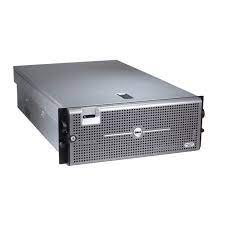What is Dell PowerEdge 2900
The Dell PowerEdge 2900 is a server model manufactured by Dell Inc. The server was released in 2006 and was designed for small and medium-sized businesses. It is a tower-based server that can support up to two Intel Xeon processors with up to six cores each, providing a total of 12 cores. The server also supports up to 64GB of memory and up to eight hard drives for storage, with various options for RAID configurations. The Dell PowerEdge 2900 is known for its reliability, scalability, and performance and is commonly used for a variety of applications, including file and print services, email, web hosting, and virtualization.
Top Tips for Maintaining and Upgrading Your Dell Poweredge 2900 Server
Here are some top tips for maintaining and upgrading your Dell PowerEdge 2900 server:
Keep the server clean:
Regularly clean the server inside and out, paying special attention to the fans, vents, and air filters. Dust and debris can accumulate and cause overheating, which can lead to hardware failures.
Monitor server health:
Use monitoring software to keep an eye on the server’s health and performance metrics, such as CPU and memory usage, disk usage, and temperature. This will help you catch any issues before they become major problems.
Keep the firmware and drivers up to date:
Regularly check for firmware and driver updates from Dell and installs them as needed. These updates can improve performance and fix security vulnerabilities.
Consider upgrading memory:
Upgrading the server’s memory can significantly improve performance, especially for memory-intensive applications like virtualization.
Upgrade hard drives to SSDs:
Replacing traditional hard drives with solid-state drives (SSDs) can greatly improve disk I/O performance and reduce power consumption.
Implement RAID:
Implementing RAID (redundant array of independent disks) can improve data reliability and protection against data loss due to hardware failures.
Backup regularly:
Implement a regular backup strategy to protect against data loss due to hardware failures, user errors, or malicious attacks.
Plan for server replacement:
Keep in mind that server hardware has a lifespan, and it’s important to plan for server replacement before it becomes a major issue. Regularly review the server’s performance and determine if it’s time to upgrade or replace the hardware.
The Benefits of the Dell Poweredge 2900 for Small and Medium-Sized Businesses
Here are some benefits of the Dell PowerEdge 2900 for small and medium-sized businesses:
Scalability:
The Dell PowerEdge 2900 is a highly scalable server that can be easily upgraded to meet the changing needs of your business. It can support up to two Intel Xeon processors with up to six cores each, up to 64GB of memory, and up to eight hard drives for storage.
Reliability:
The Dell PowerEdge 2900 is known for its reliability and uptime. It is built with high-quality components and is designed to withstand heavy workloads and demanding environments.
Performance:
The server’s powerful processors and ample memory allow it to handle complex applications and workloads with ease, making it an ideal choice for businesses that need to run resource-intensive applications or virtualization.
Manageability:
The Dell PowerEdge 2900 comes with a range of management tools that make it easy to manage and maintain the server. These tools allow you to monitor system health, configure settings, and update firmware and drivers.
Flexibility:
The Dell PowerEdge 2900 is a versatile service that can be configured to meet the specific needs of your business. It supports a range of operating systems and applications and can be used for a variety of tasks, including file and print services, email, web hosting, and virtualization.
Cost-effective:
The Dell PowerEdge 2900 offers a good balance of performance and affordability, making it a cost-effective option for small and medium-sized businesses that need a reliable and scalable server.
Security:
The server comes with a range of security features, including built-in encryption and RAID, to help protect your business-critical data from unauthorized access and data loss.
Overall, the Dell PowerEdge 2900 is a powerful, reliable, and versatile server that can provide small and medium-sized businesses with the performance and scalability they need to run their business-critical applications and workloads.
The Future of the Dell Poweredge 2900 Server: What to Expect in the Next Few Years
The Dell PowerEdge 2900 was released in 2006 and has been in the market for over a decade. While it continues to provide reliable performance, it is now an older server model and has been replaced by newer, more advanced models in the Dell PowerEdge line.
In the next few years, it is unlikely that there will be any major updates or upgrades to the Dell PowerEdge 2900 server. Instead, Dell will continue to focus on developing newer, more advanced server models that offer improved performance, scalability, and efficiency.
Dell is likely to continue to invest in the development of cutting-edge technologies such as artificial intelligence, machine learning, and edge computing, which are increasingly being used by businesses to drive innovation and growth. As such, future Dell PowerEdge servers are likely to be optimized for these workloads, with features such as enhanced GPU acceleration, specialized hardware for AI and machine learning, and support for high-speed networking and storage technologies.
Another trend that is likely to influence the future of Dell PowerEdge servers is the increasing use of cloud-based solutions. As more businesses move their workloads to the cloud, there will be less demand for on-premises servers like the Dell PowerEdge 2900. However, Dell is likely to continue to offer a range of on-premises and cloud-based solutions to meet the needs of different types of businesses.
In summary, while the Dell PowerEdge 2900 continues to provide reliable performance, it is an older server model that has been replaced by newer, more advanced models. In the future, Dell is likely to focus on developing servers that are optimized for cutting-edge technologies like AI and machine learning, as well as offering a range of on-premises and cloud-based solutions to meet the needs of businesses of all sizes.
Top Use Cases for the Dell Poweredge 2900 Server
Here are some of the top use cases for the Dell PowerEdge 2900 server:
File and print services:
The Dell PowerEdge 2900 can be used to provide file and print services to small and medium-sized businesses. With its large storage capacity, it can store and serve large volumes of data and files to users on the network.
Email and collaboration:
The Dell PowerEdge 2900 can also be used to host email and collaboration platforms such as Microsoft Exchange, enabling employees to communicate and collaborate more effectively.
Web hosting:
The server can be used to host web applications and websites for small and medium-sized businesses. With its powerful processors and ample memory, it can handle large volumes of traffic and ensure fast response times.
Virtualization:
The Dell PowerEdge 2900 can also be used as a virtualization host, allowing multiple virtual machines to run on a single physical server. This can help businesses save on hardware costs and improve server utilization.
Database management:
The server can be used to host databases such as Microsoft SQL Server, providing businesses with a reliable and secure platform for managing their data.
Backup and disaster recovery:
The Dell PowerEdge 2900 can be used to implement backup and disaster recovery solutions for businesses. With its large storage capacity, it can store backups of critical data and applications, ensuring that they can be restored quickly in the event of a disaster or data loss.
High-performance computing:
The server’s powerful processors and ample memory make it an ideal choice for high-performance computing (HPC) workloads, such as scientific simulations, data analysis, and modeling.
In summary, the Dell PowerEdge 2900 server can be used in a variety of ways to support the IT infrastructure of small and medium-sized businesses, from providing file and print services to running high-performance computing workloads. Its versatility, reliability, and scalability make it a popular choice for businesses of all sizes.
An Overview of the Dell Poweredge 2900 Server’s Hardware and Software Features
The Dell PowerEdge 2900 server is a robust and powerful server that provides reliable performance for small to medium-sized businesses. Here is an overview of its key hardware and software features:
Hardware Features:
Processors:
The server can be configured with up to two Intel Xeon processors, each with up to four cores, providing plenty of processing power for a wide range of workloads.
Memory:
The server can support up to 64GB of DDR2 memory, enabling it to handle large volumes of data and applications.
Storage:
The server can be configured with up to eight 3.5″ SAS or SATA hard drives, providing up to 8TB of storage capacity.
RAID:
The server supports RAID levels 0, 1, 5, 6, and 10, providing redundancy and data protection for critical applications and data.
Networking:
The server has four integrated Gigabit Ethernet ports, enabling it to handle high volumes of network traffic.
Expansion:
The server has multiple expansion slots, including PCI Express, PCI-X, and PCI, enabling businesses to add additional hardware as needed.
Software Features:
Operating System:
The Dell PowerEdge 2900 supports a wide range of operating systems, including Windows Server, Linux, and VMware ESXi.
Management:
The server comes with Dell OpenManage software, which provides a suite of tools for managing and monitoring the server’s hardware and software.
Virtualization:
The server is optimized for virtualization, with support for VMware ESXi and Microsoft Hyper-V.
Security:
The server comes with a range of security features, including BIOS-level security, hardware-based encryption, and integrated TPM.
Backup and Recovery:
The server supports a range of backup and recovery solutions, including Dell PowerVault tape backup systems and third-party backup software.
Overall, the Dell PowerEdge 2900 server provides a robust and flexible platform for small to medium-sized businesses. Its powerful hardware and software features make it ideal for a wide range of workloads, from file and print services to virtualization and high-performance computing.
Read also :- renting-home-oxygen-what-is-it-and-why-is-it-important
Conclusion
In conclusion, the Dell PowerEdge 2900 server is a powerful and flexible platform that can support a wide range of workloads for small to medium-sized businesses. Its hardware features, such as its powerful processors, ample memory, and large storage capacity, make it well-suited for tasks such as file and print services, web hosting, email and collaboration, database management, virtualization, backup and disaster recovery, and high-performance computing. Its software features, including a variety of supported operating systems, management and monitoring tools, virtualization support, security features, and backup and recovery solutions, make it a reliable and easy-to-manage option for businesses. Overall, the Dell PowerEdge 2900 server is a reliable and cost-effective option for businesses looking to improve their IT infrastructure and support their business operations.




